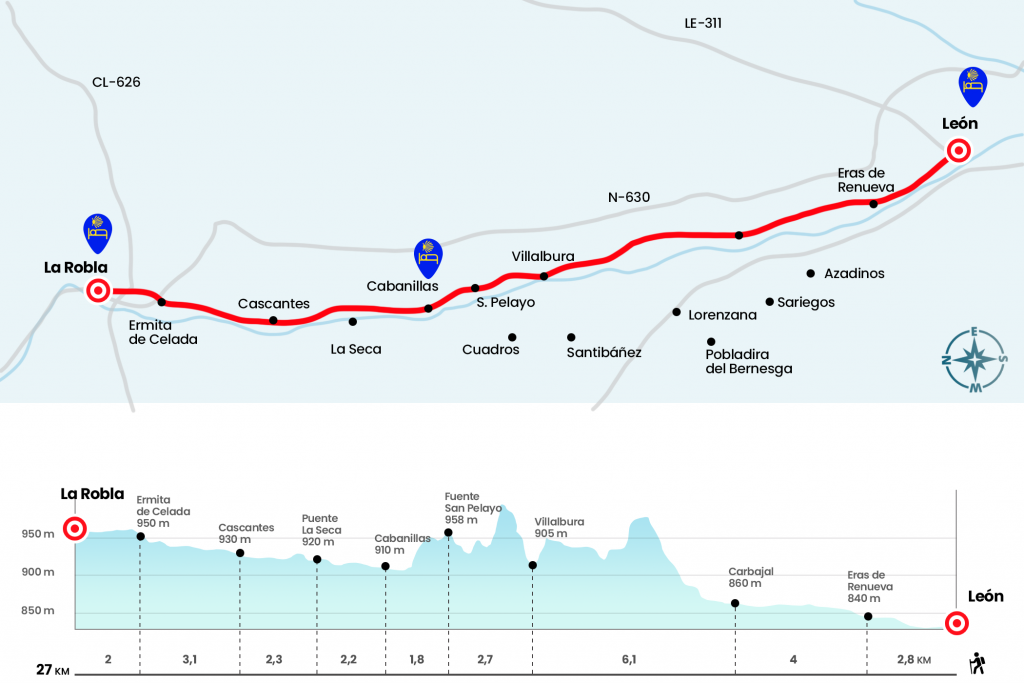Article translated by an automatic translation system. Press here for further information.
Stage from Leon to La Robla
A first stage of 17.4 kilometers to Cabanillas can be made
Information about the stage 1: Stage from Leon to La Robla

Enlarge map
The route
Introduction:
As Luciano Huidobro tells in Las Peregrinaciones Jacobeas: “Coming to the Cross of San Marcos, the pilgrims deliberated on which path they should follow. The most fearless and devout chose Oviedo.” Indeed, as the chronicles and chansons of medieval pilgrims tell us, it was not easy to go through the Leonese central mountain and the narrow Asturian valleys after the relics guarded in the Santa Chamber of Oviedo. The historian Juan Uría considers in Las Peregrinaciones a Santiago de Compostela that “the pilgrimage to Oviedo is linked to the Compostelana in the last third of the 11th century”. He also emphasizes that “it was still said at the beginning of the 19th century:Whoever goes to Santiago and not to the Savior serves the servant and leaves the Lord.” A refrain that was already cited in the Nouvelle Guide, printed in Paris in 1583. Thus, the humble 12th century pilgrims' hospital on the banks of the Bernesga, rebuilt to the great thanks to a donation by Fernando el Catlico and now Parador Nacional, represents the starting point of the San Salvador Way.
The itinerary:
- Km 0. Leon(All services)
Next to the Parador de San Marcos, there is the Cairn that reads: ‘San Salvador way. Leon-Oviedo. Cuatro Valles’. Cuatro Valles is a non-profit association, composed of 26 Leonese municipalities, which was responsible for signaling with beacons and information panels the Leonese section of this Jacobean itinerary. The yellow arrows painter of the entire itinerary between León and Oviedo and the modern father of this Camino is José Antonio Cuñarro Extac, better known by ‘Ender’.
We advance along the avenue of the Pilgrims, leaving the Territorial Delegation to the right hand. We always have the roundabout Martin Granizo, who we identified by the T-6 aircraft that presides over it (see section observations). Next to the River Bernesga and its walk (left hand of the itinerary) we will travel the district of Eras de Renueva. Passing the I.E.S Eras de Renueva and the urbanizations Santa Engracia and la Vega de Eras we reach the roundabout that puts an end to the avenue, where we turn right onto Unicef street (Km 2,8).
This high-standing urbanization leads directly to the Carbajal road. We followed it to the left and passed first by the San Cayetano complex before passing the municipality of León (Km 4.8). This is the case of Sariegos, to which Carbajal de la Legua belongs. Crossing this locality is excessive and, at the Central Bar, the headquarters of the Camino de Santiago Ruta Association of San Salvador, we have the opportunity to seal the credential and even acquire it.
- Km 6.8. Carbajal de la Legua (All services)
Beware! In the vicinity of the bar there are a couple of shops where you should buy some groceries, as, until Cascantes, kilometer 21.9 stage, there is no service. Anyone who goes overnight at the hostel in Cabanillas should also keep it in mind to also buy dinner and breakfast. At the exit of Carbajal we came across a more than curious sculpture, made in tribute to the pilgrims of this Jacobean route. There is a large dirt track that ends the urban section of this day (Km 7,9).
We exceed about 90 meters of level in the first shipment and, at the beginning of the descent (Km 9.8), always in the warmest months, we will meet, surely, with an army of mosquitoes that campers their wide laying eggs in the buds and yolks of the robledal nutrite. Nevertheless, it is a beautiful section. In addition to oaks, carrascas, torvisci and jaras lead a select representation of the Mediterranean Mount. The path narrows in some sections, creating tunnels between the bushes. In others, the path takes air and allows you to appreciate the valley and the forest gallery of the Bernesga River. This leads to the depopulation of Villalbura (left hand source, 30 ms. from the Camino).
- Km 12.9. Despoblado de Villalbura(Fuente. Medicine chest. Book of signatures)
Once a proud population, sown with vines and cereal, today it only has a mailbox that holds a book of signatures, puppies, Betadine and other sanitary facilities. Look! On a curve, about 150 meters later, we leave the track on the right and we climb up a trocha at a high level. It is well worth the effort, which gives us another luxurious panorama of the Bernesga Valley. We reach a hill (Km 13.9) and descend by track.
Half a kilometer later there is the possibility of taking a shortcut, but we do not take it to spend a rest area with a fountain (Km 14,7). Anyway, a little later, in the place of San Pelayo, where there was an old cenobium, we have another place of rest, also with a book of signatures and another source (Km 15,6). From Cabanillas, already in sight, only 20 minutes apart. During the short journey we will only have to pay attention to a change of direction, which is well marked, which we will take to the left.
- Km 17.4. Cabanillas(Hostel)
We arrived at this small town in the municipality of Esquel down Calle Real. Soon we passed by the chapel of the Holy Christ in sober brick. It is the home of the local brotherhood of the blessed Christ of Vera Cruz, with over 4 centuries of reception and hospitality to the pilgrim behind him. Upon arriving at the fountain we see the diversion to the pilgrims' hostel, which is only 100 meters on the right hand. The Camino, on the other hand, moves forward and rotates 90º to the right as soon as the canal of the stream of Cabanillas passes. Our steps again approach those of the Bernesga River, whose course we dominate from the path that runs along the slope. A ‘Cuatro Valles’ panel adds information about the holm oaks and understory of the Bernesga (Km 18,8). Eight hundred meters later we reached the bridge that leads to the center of La Seca, with a bar, although the Camino de San Salvador does not cross the channel, but progresses in front.
- Km 19.6. Access bridge to La Seca (Bar 400 meters from the Camino)
Thus, with the panoramic view of La Seca across the river, the path winds at half a slope overcoming several slides. In the valley, after the holm oaks, there will be chopsticks that will give us shade until we cross LE-4514. We entered Cascantes by the access road, also Calle Real. This locality in the municipality of Tablas has a font lady of three caños, of 2014, from which the water is usually flushed. Also a simple church of the 18th century, dedicated to San Pedro. In the bar we can seal the credential.
- Km 21.9. Cascantes(Bar)
We fired Cascantes with the increasingly closer presence of the La Robla thermal plant. The access road leads to the LE-4514, which we left on the left before P.k 14. A road brings us soon to the hermitage of Celada, which seems to emerge sheltered from the huge thermal power station that sombrezes it. It maintains some element of the 14th century, like a Gothic arch, dating back to the rest of the 17th and 18th centuries. The interior features a polychrome Romanesque carving of the Virgen de las Nieves/, patron of La Robla.
- Km 25. Hermitage of Celada
In 2014, the pilgrim's hand was placed on the entrance door to the enclosure, which reads: “Put your hand on mine and that the goodness and love that it contains within you permeates this place.” We soon surpassed the N-630 below and later accessed an elevated bridge over the tracks, which dies on Ramón y Cajal street in La Robla (Km 26). There is no loss, we must always go ahead, through the streets Ramón y Cajal and Mayor, until the end of this Leonese town. The hostel (temporarily closed 2022) is located next to the park of the Huerga.
- Km 27. La Robla(All services)
The difficulties
Remarks
In images
What to see, what to do
The hostels

¿Do you want to send any photo of "The Camino de Santiago"?
If you have any photos of "El Camino de Santiago" that you want to share with us, you can send them to us and enlarge the photo gallery

Forum: What pilgrims think about the Camino de Santiago
See all